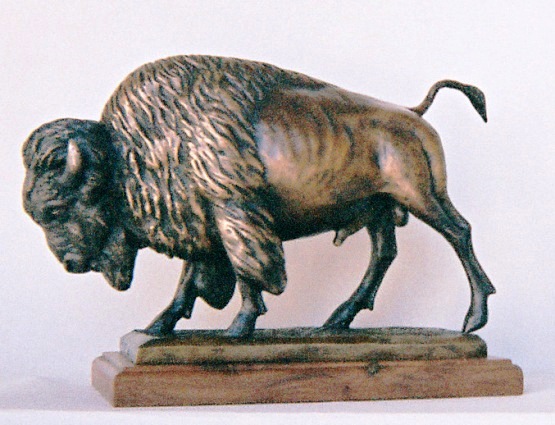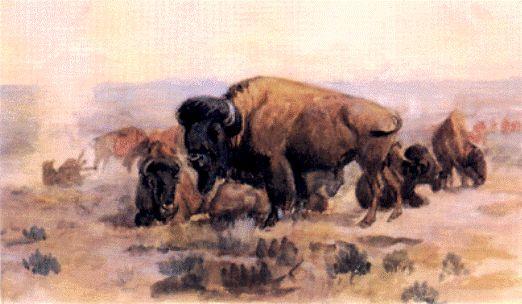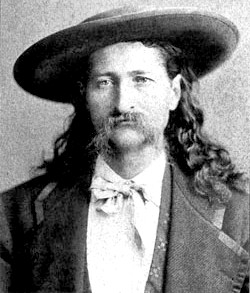"At the period of which I write, in (winter)
1868, the Plains were covered with vast herds of buffalo—the
number has been estimated at 3,000,000 head—and with such
means of subsistence as this everywhere at hand, the 6,000 hostiles
were wholly unhampered by any problem of food-supply. The savages
were rich too according to Indian standards, many a lodge owning
from twenty to a hundred ponies; and consciousness of wealth and
power, aided by former temporizing, had made them not only confident
but defiant."
Quote from PERSONAL MEMOIRS OF PHILIP. H. SHERIDAN
VOLUME II. Part 6 CHAPTER XII
"These men (the buffalo hunters) have done more
to settle the vexed Indian question than the entire regular army
has done in the last thirty years. They are destroying the Indians'
commissary. Send them powder and lead if you will, but for the sake
of a lasting peace let them kill, skin and sell until the buffalo
are extermininated. Then your prairies can be covered with speckled
cattle and the festive cowboy who follows the hunter as the second
forerunner of an advanced civilization."--General Philip H.
Sheridan
William Cody while in the Kansas territory and
upon meeting a group of military men preparing for a buffalo hunt
in the summer of 1868. He gave the following account of how he won
his name.
Source: LAST OF THE GREAT SCOUTS (BUFFALO BILL)
BY HELEN CODY WETMORE AND ZANE GREY
 American Bison by Chester Comstock
American Bison by Chester Comstock
commissioned to honor donors to
"The Villages" Florida charter school
© 2007 Comstock Sculpture Studio
"Come along with us," offered the captain
graciously. "We’re going to kill a few buffalo for
sport, and all we care for are the tongues and a chunk of the
tenderloin; you can have the rest.
"Thank you," said Will. "I’ll
follow along."
Nearby there were eleven buffaloes in the herd,
and the officers started after them as if they had a sure thing
on the entire number. Will noticed that the game was pointed toward
a creek, and understanding "the nature of the beast,"
started for the water, to head them off.
As the herd went past him, with the military
quintet five hundred yards in the rear, he gave Brigham’s
blind bridle a twitch, and in a few jumps the trained hunter was
at the side of the rear buffalo; Lucretia Borgia spoke, and the
buffalo fell dead. Without even a bridle signal, Brigham was promptly
at the side of the next buffalo, not ten feet away, and this,
too, fell at the first shot. The maneuver was repeated until the
last buffalo went down. Twelve shots had been fired; then Brigham,
who never wasted his strength, stopped. The officers had not had
even a shot at the game. Astonishment was written on their faces
as they rode up.
"Gentlemen," said Will, courteously,
as he dismounted, "allow me to present you with eleven tongues
and as much of the tenderloin as you wish."
"By Jove!" exclaimed the captain, "I
never saw anything like that before. Who are you, anyway?"
"Bill Cody’s my name."
"Well, Bill Cody, you know how to kill buffalo,
and that horse of yours has some good running points, after all."
"One or two," smiled Will.
Captain Graham—as his name proved to be
— and his companions were a trifle sore over missing even
the opportunity of a shot, but they professed to be more than
repaid for their disappointment by witnessing a feat they had
not supposed possible in a white man—hunting buffalo without
a saddle, bridle, or reins. Will explained that Brigham knew more
about the business than most two-legged hunters. All the rider
was expected to do was to shoot the buffalo. If the first shot
failed, Brigham allowed another; if this, too, failed Brigham
lost patience, and was as likely as not to drop the matter then
and there.
It was this episode that fastened the name of
"Buffalo Bill" upon Will, and learning of it, the friends
of Billy Comstock, chief of scouts at Fort Wallace, filed a protest.
Comstock, they said, was Cody’s superior as a buffalo-hunter.
So a match was arranged to determine whether it should be "Buffalo
Bill’ Cody or "Buffalo Bill" Comstock.
 Charlie Russell's painting of a Bull Buffalo
Charlie Russell's painting of a Bull Buffalo
The hunting-ground was fixed near Sheridan, Kansas,
and quite a crowd of spectators was attracted by the news of the
contest. Officers, soldiers, plainsmen, and railroad men took
a day off to see the sport, and one excursion party, including
many ladies, among them Louise, came up from St. Louis.
Referees were appointed to follow each man and
keep a tally of the buffaloes slain. Comstock was mounted on his
favorite horse, and carried a Henry rifle of large calibre. Brigham
and Lucretia went with Will. The two hunters rode side by side
until the first herd was sighted and the word given, when off
they dashed to the attack, separating to the right and left. In
this first trial Will killed thirty-eight and Comstock twenty-three.
They had ridden miles, and the carcasses of the dead buffaloes
were strung all over the prairie. Luncheon was served at noon,
and scarcely was it over when another herd was sighted, composed
mainly of cows with their calves. The damage to this herd was
eighteen and fourteen, in favor of Cody.
In those days the prairies were alive with buffaloes,
and a third herd put in an appearance before the rifle-barrels
were cooled. In order to give Brigham a share of the glory, Will
pulled off saddle and bridle, and advanced bareback to the slaughter.
That closed the contest. Score, sixty-nine to
forty-eight. Comstock’s friends surrendered, and Cody was
dubbed "Champion Buffalo Hunter of the Plains."
The heads of the buffaloes that fell in this
hunt were mounted by the Kansas Pacific Railroad Company, and
distributed about the country, as advertisements of the region
the new road was traversing. Meanwhile, Will continued hunting
for the Kansas Pacific contractors, and during the year and a
half that he supplied them with fresh meat he killed four thousand
two hundred and eighty buffaloes. But when the railroad reached
Sheridan it was decided to build no farther at that time, and
Will was obliged to look for other work.
End of story from: LAST OF THE GREAT SCOUTS (BUFFALO
BILL)
Comstock's story ended a few months after his
contest with Bill Cody. During the summer and into the fall of
1868 indians were on the rampage in the Kansas territory. As to
the nature of their activities and Comstock's death see the follow
excerpt from Gen, Philip Sheridan's Memoirs.
"Leaving the Saline, this war-party crossed
over to the valley of the Solomon, a more thickly settled region,
and where the people were in better circumstances, their farms
having been started two or three years before. Unaware of the
hostile character of the raiders, the people here received them
in the friendliest way, providing food, and even giving them ammunition,
little dreaming of what was impending. These kindnesses were requited
with murder and pillage, and worse, for all the women who fell
into their hands were subjected to horrors indescribable by words.
Here also the first murders were committed, thirteen men and two
women being killed. Then, after burning five houses and stealing
all the horses they could find, they turned back toward the Saline,
carrying away as prisoners two little girls named Bell, who have
never been heard of since."
When this frightful raid was taking place, Lieutenant
Beecher, with his three scouts—Comstock, Grover, and Parr—was
on Walnut Creek. Indefinite rumors about troubles on the Saline
and Solomon reaching him, he immediately sent Comstock and Grover
over to the headwaters of the Solomon, to the camp of a band of
Cheyennes, whose chief was called "Turkey Leg," to see
if any of the raiders belonged there; to learn the facts, and
make explanations, if it was found that the white people had been
at fault. For years this chief had been a special friend of Comstock
and Grover. They had trapped, hunted, and lived with his band,
and from this intimacy they felt confident of being able to get
"Turkey Leg" to quiet his people, if any of them were
engaged in the raid; and, at all events, they expected, through
him and his band, to influence the rest of the Cheyennes. From
the moment they arrived in the Indian village, however, the two
scouts met with a very cold reception. Neither friendly pipe nor
food was offered them, and before they could recover from their
chilling reception, they were peremptorily ordered out of the
village, with the intimation that when the Cheyennes were on the
war-path the presence of whites was intolerable. The scouts were
prompt to leave, of course, and for a few miles were accompanied
by an escort of seven young men, who said they were sent with
them to protect the two from harm. As the party rode along over
the prairie, such a depth of attachment was professed for Comstock
and Grover that, notwithstanding all the experience of their past
lives, they were thoroughly deceived, and in the midst of a friendly
conversation some of the young warriors fell suddenly to the rear
and treacherously fired on them.
At the volley Comstock fell from his horse instantly
killed. Grover, badly wounded in the shoulder, also fell to the
ground near Comstock Seeing his comrade was dead, Grover made
use of his friend's body to protect himself, lying close behind
it. Then took place a remarkable contest, Grover, alone and severely
wounded, obstinately fighting the seven Indians, and holding them
at bay for the rest of the day. Being an expert shot, and having
a long-range repeating rifle, he "stood off" the savages
till dark. Then cautiously crawling away on his belly to a deep
ravine, he lay close, suffering terribly from his wound, till
the following night, when, setting out for Fort Wallace, he arrived
there the succeeding day, almost crazed from pain and exhaustion.
PERSONAL MEMOIRS OF P. H. SHERIDAN VOLUME II. Part
6 CHAPTER XII.
Publisher: Charles L. Webster & Company 1888
William Comstock met his death on August 27,
1868, in his twenty-sixth year.
Due to the hostilities being conducted by the
indians Sheridan prepared his command to conduct a winter campaign
against the raiders. The plight of the indians and the future
of free ranging hunting parties in pursuit of buffalo essentially
had come to end. The Medicine Lodge treaty of Oct. 1867 stipulated
that the indians would retire to designated reservations and that
Indians roaming outside of the reservations were in violation
of the treaty.
Gen. Philip Sheridan submitted the following
report to General Sherman dated November 1, 1869 describing the
military operations in the Department of the Missouri from October
15, 1868 through March 27, 1869. The report included a sworn statement
from Edmund "Guerriere" which was titled "In
the field, Medicine Bluff Creek, Wichita Mountains, February 9th,
1869." Guerrier's statement was this:
"I was with Cheyenne Indians at the time
of the massacre on the Solomon and Saline rivers in Kansas, the
early part or middle of last August, and I was living at this
time with Little Rock's band. The war party who started for the
Solomon and Saline was Little Rock's, Black Kettle's, Medicine
Arrow's and Bull Bear's bands; and as near as I can remember,
nearly all the different bands of Cheyennes had some of their
young men in this war party which committed the out rages and
murders on the Solomon and Saline. Red Nose, and The-man-who-breaks-the-marrow
bones, [Ho-eh-a-mo-a-hoe] were the two leaders in this massacre;
the former belonged to the Dog Soldiers, and the latter in Black
Kettle's band. As soon as we heard the news by runners who came
on ahead to Black Kettle - saying that they had already commenced
fighting, we moved from our camp on Buckner's Fork of the Pawnee,
near the head waters, down to North Fork, where we met Big Jake's
band, and then moved south, across the Arkansas river; and when
we got to the Cimarron, George Bent and I left them and went to
our homes on the Purgatoire."
Sheridan seems to use this statement, in part,
as justification for Custer's attack on Black Kettle's encampment
at Washita.
The year 1867 with the signing of the Medicine
Bow Treaty marks the end of the old west and the beginning of
the wild west.
During his command of the Department
of the Missouri Sheridan sought out and hired the best men
he could find to be guides for his military units. Among the
men he hired for this position were William Cody and William
Comstock and Wild Bill Hickock. All three if these men had
been ponie express riders during its brief history.

Wild Bill Hickock was a friend and
companion of Buffalo Bill Cody as a buffalo hunter in the
Kansas Territory

George Armstong Custer
was one of Sheridans favorite subordinates during his
Missouri Command
"On the first of June1867 , with about three
hundred and fifty men and a train of twenty wagons, I left Fort
Hays and directed our line of march toward Fort McPherson, on
the Platte River, distant by the proposed route two hundred
and twenty-five miles. The friendly Delawares accompanied us
as scouts and trailers, but our guide was a young white man
known on the Plains as Will Comstock. No Indian knew the country
more thoroughly than did Comstock. He was perfectly familiar
with every divide, water-course, and strip of timber for hundreds
of miles in either direction. He knew the dress and peculiarities
of every Indian tribe, and spoke the languages of many of them.
Perfect in horsemanship, fearless in manner, a splendid hunter,
and a gentleman by instinct, as modest and unassuming as he
was brave, he was an interesting as well as valuable companion
on a march such as was then before us. Many were the adventures
and incidents of frontier life with which he was accustomed
to entertain us when around the camp-fire or on the march. Little
did he then imagine that his own life would soon be given as
a sacrifice to his daring, and that he, with all his experience
among the savages, would fall a victim of Indian treachery."
Quoted from the Memoirs of Gen. George Armstrong
Custer
Standard Issue of Cavalry soldier's
riding gear during the Indian Wars. Image has a link to
articles about Sheridans Buffalo Soldiers the 9th and 10th
Cavalry
Articles on the expansion
of the American west and the fate of the American Buffalo
during the American 19th century
|
